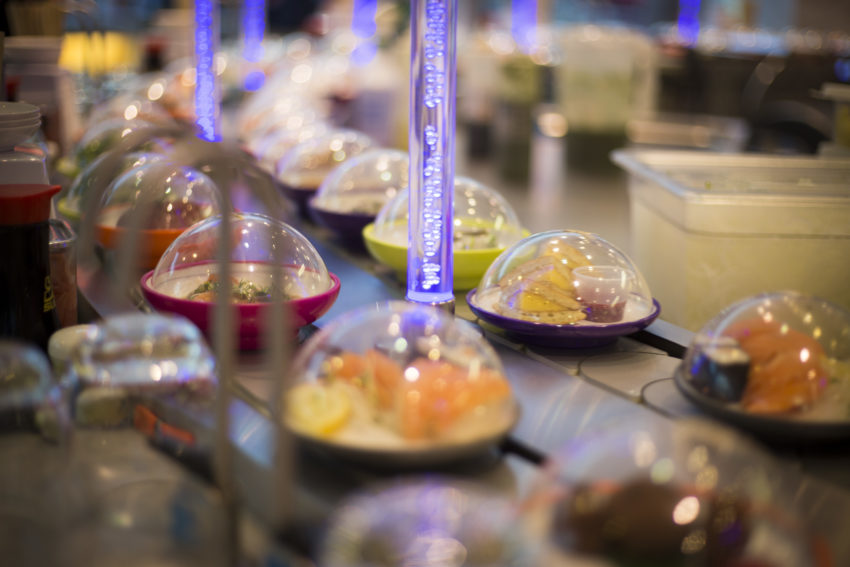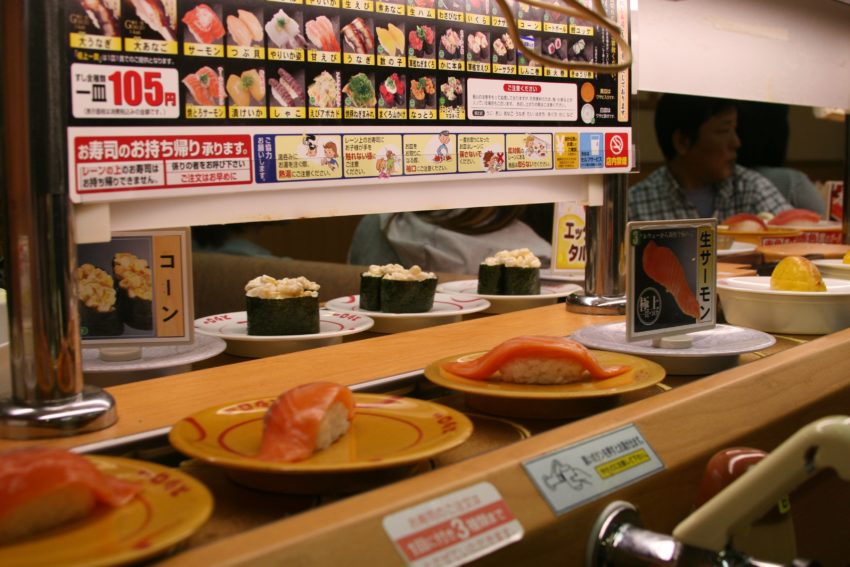Books: The History of Sushi
April 30, 2021 · 0 comments
By Jonathan Clements.

Eric C. Rath observes that in the anime series Sushi Police, fish are portrayed weeping at the injustices done to them by culinary criminals. Luckily, a three-man team travels the world “armed with wasabi machine guns, a vacuum to collect illicit sushi and chopstick nunchaku.” Sushi Police is, or course, bonkers, but it captures for Rath the increasingly strict ideas in Japan about what sushi should be, and that there is something somehow “dubious” or “unhealthy” about sushi not made by Japanese hands. But as he argues in his new book Oishii: The History of Sushi, the foodstuff is a truly global phenomenon, part of a network that extends to Thai aquaculture farms and South Atlantic fishing grounds, small-town buffets and supermarket shelves.
Rath’s book is a joy because he is such a trustworthy narrator. His breezy, approachable text comes backed by hard-core examination of hundreds of Japanese-language sources, and an incisive grasp of some of the controversies and blind-spots on which even Japanese experts cannot agree.
A few years ago, while on the road with National Geographic, I found myself participating in the manhood ceremony of a Hmong boy somewhere up a mountain in the Chinese province of Guizhou. One of the rituals involved the passing round of slabs of preserved fish – hunks of chewy, sour flesh, at least nominally edible, kept for months in jars, subjected to lactic acid fermentation to kill off any dangerous microbes. I was not a fan of this food, known in Chinese as zhi, particularly because I ended up with multiple hard fish-scales stuck in my teeth and gums. But according to Rath, I was actually enduring one of the earliest forms of the food that would one day be known as sushi.

Sushi as we know it is a relatively recent phenomenon, arising in the hustle and bustle of samurai-era Edo, where it was once known as Edomae-zushi (“morsels from the estuary”). But those varieties, of what is more exactingly known today as nigirizushi didn’t even show up in cookbooks of the period, being regarded as a street food so simple and ubiquitous that nobody needed to be told how to make it – much as Nigella Lawson would never waste her time telling you how to put butter on toast.
For many of you, it is even more recent than that, dating to the rise of local franchises like Itsu and Yo Sushi, ever ready to serve modern-day developments like the California Roll. But Rath’s exhaustive history tracks the food back to its Dark-Age origins, through a long process of transformations that have led to its evolution into an entirely different entity.
Rath’s starting off point, as it is for almost all historians of Asian food, is The Essential Techniques for the Welfare of the People (Qimin Yaoshu), a 6th-century AD Chinese agricultural manual that, quite by chance, is the earliest extant source for many recipes, foodstuffs and techniques. One recipe within is an advanced fermentation technique to make what the Japanese now call funazushi, a fish pickled in salt and rice. In this early method, the rice base is often rendered so sour that it is almost inedible, and is discarded when the dish is served. Despite being the primal ancestor of almost all those dishes you see on the conveyor belt at the sushi bar, Rath reports that funazushi is so obscure and reviled that only 5.9% of the Japanese themselves have ever tried it.

Early fish-fermentation dishes arrived with a particular group of migrants from the Asian mainland, and spread through central Japan – there is no evidence of sushi-eating before the modern era in either Hokkaido in the north, or Okinawa in the south. Rath takes great pains to point out that much common folklore about sushi, even in Japan itself, is highly doubtful – modern writers associate sushi specifically with rice, but even this assumption only dates to the last 200 years.
Pickled fish, in fact, may even predate the evolution of human beings, since Rath notes the existence of osprey sushi, a supposed delicacy from Izumi province, where wild birds of prey have been observed hunting for fish they do not yet need to eat, burying them at the sea’s edge and letting them naturally steep in sea water. To keep other birds away from their food cache, they apparently piss on it, which has to be the least appetising sushi I have ever heard of. However, Rath suggests that this is an urban myth that has grown up to explain the ammonia-smell of sea-salted fish, like the similarly stinky Icelandic rotting-shark hakarl.
As you’ve probably guessed by now, the word sushi has meant different things at different times – just as with Chinese food history, many popular accounts are wrong-footed by assuming that ancient words carry the same definition today as they did in the past. One medieval text (coincidentally, the same one that provided the source for Hayao Miyazaki’s Nausicaa) mentions a “sushi” dish so sour that if you accidentally threw up in a barrel of it, it was possible to mix the vomit in and leave nobody any the wiser. So yes, let’s try to steer clear of Kyoto haute-cuisine, and fast-forward to the early modern period, where the removal of Japan’s power-base to the Edo (Tokyo) of the Tokugawa Shogun exposed the opinion-formers and power-brokers of urbanising Japan to fresh seafood, a world away from landlocked Kyoto.

It’s here, at last, that we get sushi as you and I might recognise it – parcels of rice gently steeped in vinegar, with a savoury morsel and maybe even a seaweed wrapper. Even then, there are surprises, including a “hot sushi” served as a winter warmer. Rath takes us, here, into the world of the cognoscenti, such as the smart chefs who know not to buy Izumo mackerel because it might have been delayed a crucial extra day in getting to market.
As late as 1907, there were only six sushi restaurants in Tokyo – it was still a street food that most people ate standing up, served by a bunch of chancers sometimes caught dyeing tofu and calling it bluefin tuna, or passing off fishcakes as squid. By the 1930s, sushi stalls have sprung up “like bamboo shoots after a rainstorm”, particularly hip entertainment districts like Asakusa. Rath chronicles the little shunts in evolution, like a wartime custom for distracting customers from dwindling fish pieces by serving two pieces of sushi at a time – a style that endures today. Wartime and post-war sushi, in fact, including the dishes served today, are two and a half times smaller than they were before the 1940s – austerity conditions were once so severe that customers had to bring their own rice.

As for the sort of gate-keeping that continues to characterise the Sushi Police, the Japanese government didn’t start issuing licences to sushi chefs until 1958, the same year that Yoshiaki Shiraishi, inspired by a visit to a meat-packing factory or a beer-bottling plant, installed the first sushi conveyor belt. In other words, the “industrialisation” of what was once a street food, with factory-cut slices, staff plating dishes like car-workers on an assembly line, and customers at the counter like cattle at a feed-trough, comes hand-in-hand with the authorities’ ever-more hysterical assertions that sushi is a posh nosh.
Rath finishes where he started, with the sudden leap of sushi out of Japan in the 1980s to become a truly global fast food. California had sushi bars in the 1960s, but the food is far more recent in most other parts of the world. Youngsters may not realise, but the everyday sight of a sushi bar at Stansted Airport, or a bento in Sainsbury’s, is truly a phenomenon that has only arisen in the last couple of decades. The small Finnish town I moved to in 2011 didn’t have a single sushi bar to its name; today it has four or five, none of them run by Japanese people. Rath lists a bunch of other local variants, some well-known like the ubiquitous California roll, but others more obscure: the Philadelphia roll, the Las Vegas roll, the San Francisco roll… In an anecdote I have seen him repeat elsewhere, clearly a trauma recalled with pearl-clutching horror, Rath recalls finding a self-styled sushi bar on the windswept Chinese plateau of Qinghai, in sight of the Himalayas, where a local dive served rice wrapped around Spam, and called it “Korean sushi”.

Rath chronicles the rise of sushi in the mass-media, zeroing in on a scene in The Breakfast Club where Molly Ringwald’s urbane sophistication (or perhaps pretention) is signified by her bento lunch, and the fact she has to explain what sushi is to the school tough-guy.
“You won’t accept a guy’s tongue in your mouth, and you are going to eat that?” he retorts.
Rath finishes with a chapter on where sushi may end up tomorrow, with glimpses of some odd fusion ideas like a sushi bagel and a funazushi sandwich. Your mileage may vary, I’m done with funazushi for now.
Jonathan Clements is the author of The Emperor’s Feast: A History of China in Twelve Meals. Eric C. Rath’s Oishii: The History of Sushi is published by Reaktion.
Leave a Reply